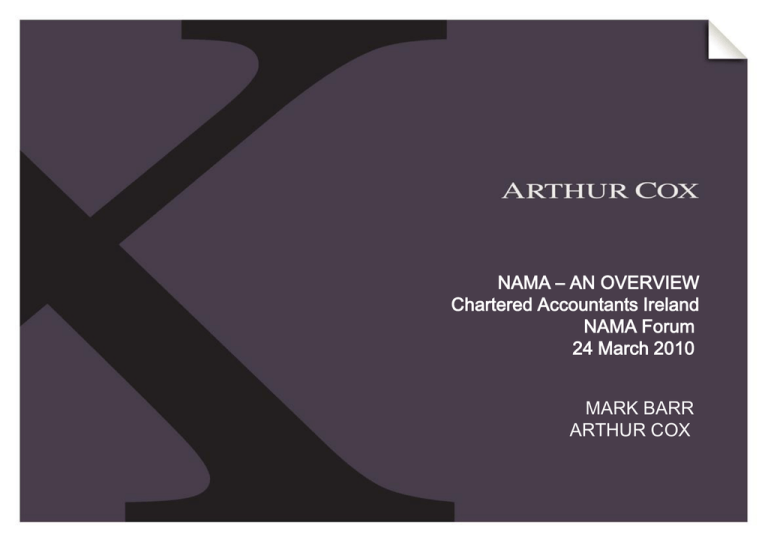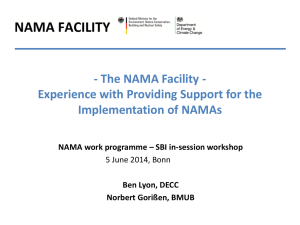NAMA - Chartered Accountants Ireland
advertisement

NAMA – AN OVERVIEW Chartered Accountants Ireland NAMA Forum 24 March 2010 MARK BARR ARTHUR COX INTRODUCTION 1. Background 2. Why NAMA? 3. NAMA Portfolio 4. Designation of Participating Institutions 5. Acquisition Process 6. Valuation 7. Appeals 8. Non Irish Assets 9. Governance and Accountability 10. NAMA Specific Powers relevant to Real Estate 1 BACKGROUND • • • • • • Massive growth in property related lending 2004-2007 by Irish Credit Institutions. Over reliance on wholesale money markets. Insufficient attention to key issues of supply/demand/risk analysis. Regulatory failures Worldwide financial crisis of September 2008 including collapse of Lehman Brothers Irish Government became deeply involved in the banking system when it provided a wide-ranging guarantee for bank liabilities on 30 September 2008. • Irish Government nationalised Anglo Irish Bank in January 2009 and recapitalised AIB and BOI (€3.5 billion each) in Spring 2009. • Government decision in April 2009 to establish the National Asset Management Agency. • NAMA Act passed end November 2009 and Act commenced on 21 December 2009. 2 NAMA WAS ESTABLISHED TO: •Address a serious threat to the economy of the State; •Stabilise Irish Credit Institutions; •Stabilise Irish Financial system; •Protect the State’s interest in the State guarantee of Credit Institutions; •Restore confidence in the banking sector; AND WITH THESE PRIMARY FUNCTIONS IN MIND NAMA WILL: •Acquire €77 billion (estimated book value) of land and development loans and associated loans from Irish credit institutions. •Manage, hold, dispose, develop or enhance these assets for the benefit of the taxpayer and to achieve the best possible return for the State over a seven to ten year timeframe. •Transfer to NAMA borrower exposures across all institutions in tranches starting with the top ten exposures which are currently in the process of transferring. There will then be a phased transfer of remaining borrowers with a target of end July 2010 for completion. 3 NAMA POWERS • • • • • • • • • • • • • • Lend Borrow or raise funds, including the issuance of bonds NAMA may borrow up to €5bn Give guarantees or sureties Form or take an interest in companies Enter into partnerships or joint ventures Establish trusts Borrow or lend securities, including equity and debt instruments Purchase other property, assets or rights Invest Sell or dispose of property or investments Undertake land and property development to realise the full value of acquired assets Appoint Statutory receivers Compulsory purchase and vesting orders 4 NAMA PORTFOLIO NAMA Portfolio breakdown by institution – Estimates € Billions Land & Development Loans Associated Loans Total Billions AIB 17.0 7.1 24.1 Anglo 16.3 12.1 28.4 BOI 10.0 5.5 15.5 EBS 0.5 0.3 0.8 INBS 5.6 2.7 8.3 Total € bn 49.4 27.7 77.1 Source – National Asset Management Agency € 5 Portfolio breakdown – Asset Type & Location € Billions Ireland UK (incl NI) Other (USA/Europe) Total billions Percent Land & Development 33.1 10.3 3.3 2.7 49.4 (64%) Associated Loans 18.1 5.6 1.5 2.2 27.7 (36%) Total €billions 51.5 15.9 4.8 4.9 77.1 (100%) Percent 67% 21% 6% 6% 100% Source – National Asset Management Agency € & 6 Portfolio breakdown – Asset Type Split of Eligible Loan Book for Transfer by type Associated Loans, €28bn, 36% Land, €28bn, 37% Development €21bn, 27% Source – National Asset Management Agency 7 DESIGNATION OF PARTICPATING INSTITUTIONS • Credit Institutions in the State were entitled to apply to the Minister for Finance to become a Participating Institution within 60 days of the establishment day (21 December 2009) which expired on 19 February 2010. • The effect of making an application is that:• • the relevant credit institution and all of its subsidiaries are deemed to have applied to become Participating Institutions. the relevant credit institution and all of its subsidiaries undertake (subject to any prohibition in any applicable law (i.e. non-Irish law)) to comply with all provisions of the Act and regulations made thereunder. In other words non-Irish Participating Institutions are deemed to have entered into a statutory contract with NAMA to comply with the terms of the NAMA Act. • The Minister for Finance (after consultation with the Governor of the Central Bank and the Financial Regulator) may designate an applicant credit institution (and its subsidiaries) as a Participating Institution. • The Minister has since designated AIB Group, Bank of Ireland, Anglo Irish Bank, Irish Nationwide Building Society and Educational Building Society as Participating Institutions. • The EU Commission has also sanctioned NAMA for State aid purposes subject to an annual review of the exercise of certain of its powers. 8 ACQUISITION PROCESS • Participating Institutions are required to disclose to NAMA details of all of their eligible bank assets. • NAMA selects eligible bank assets for acquisition adopting a “borrower centric” approach prioritising the largest exposures across all participating institutions. • NAMA undertakes due diligence on eligible bank assets – legal and financial. • NAMA will not acquire credit facilities made after 31 December 2008 unless they are refinancing a facility which existed prior to 31 December 2008. • For administrative purposes NAMA has stated that it will not acquire loans having a book value of less than €5million. • NAMA prepares acquisition schedules detailing relevant loans to be acquired in each case and service of an acquisition schedule is effectively a statutory transfer of those loans to NAMA for the value NAMA attributes to the loans. • NAMA acquires relevant loans on their existing terms. • Payment to be made by issue of government guaranteed NAMA bonds to P.I.s together with subordinated bonds for 5% of the consideration in each case (maturity of subordinated bonds will be dependent on NAMA realising full value of loan(s) acquired). 9 VALUATION – Long-term Economic Value (LEV) • NAMA will apply long term economic value to the loans it will acquire which will be the value which NAMA can reasonably expect to realise on its acquired assets over a 7 – 10 year horizon. • Adjustment factors will be applied to current market value of the underlying secured properties to determine the LEV of those properties. • Adjustment factors will be determined by the extent to which current prices/yields have deviated from long-term trends. Prices/yields for the 2005-2008 period (the bubble period) will be ignored for this purpose. • Econometric analysis on correlations between property prices, GDP, demographics and other variables will be considered. 10 LEV (continued) • Maximum uplift per property: 25%. • Maximum aggregate uplift per institution on total property collateral: 20%. • Potential 0% uplift on land which, in NAMA’s view has no prospect of development and for incomplete developments which have limited sale prospects. • NAMA has an absolute discretion whether to acquire loans or not but participating institutions are required to disclose to NAMA all of its eligible loans for NAMA to decide what to acquire or otherwise. 11 APPEALS BY PARTICIPATING INSTITUTIONS • In the first instance a participating institution is entitled to object to a loan being included in an acquisition schedule on the basis that it is not an eligible bank asset. • The legislation contains a mechanism for the matter to be referred to an “expert reviewer” who will make a recommendation to the Minister for Finance who will make the ultimate decision. • Participating institutions are entitled to appeal only the valuation of the entire portfolio of loans they transfer to NAMA not on a loan by loan basis. • Minister for Finance will establish a valuation panel for the purposes of dealing with portfolio valuation appeals. 12 FOREIGN (NON-IRISH) ASSETS • As can be seen from the earlier table a considerable amount of assets likely to be transferred to NAMA are situated outside of Ireland including in the UK and the US and are therefore governed by laws other than those of Ireland. • Under the Act if the proposed transfer of an asset to NAMA is governed by the law of a foreign jurisdiction and the law of that jurisdiction allows the transfer to take place the Participating Institution can be directed by NAMA to do everything necessary to effect the transfer. • If the law of a foreign jurisdiction does not permit the transfer of the asset a Participating Institution can be directed by NAMA to do all that is permitted under such foreign law to assign to NAMA the greatest interest possible in the foreign asset. The Participating Institution will then effectively hold the asset on trust for the benefit of NAMA. • As a matter of statutory contract, non-Irish Participating Institutions will be required to comply with the terms of the NAMA Act. 13 GOVERNANCE • NAMA Board – seven members appointed by Minister for Finance plus CEO of NAMA and Chief Executive of NTMA. • Minister nominates a member of the Board as Chairperson. • Minister, after consulting Chairperson of NAMA and Chief Executive of NTMA, appoints CEO of NAMA. • CEO of NAMA is accountable officer for Oireachtas Public Accounts Committee. • 4 Board Committees – Credit\Risk\Audit\Finance. • NTMA provides staff and support services to NAMA. 14 NAMA ACCOUNTABILITY Annual Statement to Minister and Oireachtas. Annual Report & Accounts. Quarterly Reports to Minister and Oireachtas. Oireachtas committees – Chairman and CEO will give evidence whenever requested to do so. • Comptroller & Auditor General. • EU Commission (through Financial Regulator and otherwise) to audit and ratify loan valuations. • • • • 15 NAMA SPECIFIC POWERS RELEVANT TO REAL ESTATE • • • • • Statutory Receivers Vesting Orders Compulsory Purchase Development of Land Miscellaneous 16 STATUTORY RECEIVERS – SECTIONS 147 TO 151 • If power of sale/power to appoint a receiver has become exercisable NAMA may appoint a Statutory Receiver of property the subject of a bank asset. • Statutory Receiver’s Powers:• As per security documents • As per Companies Acts • Supplemented by powers set out in Schedule 1 to NAMA Act • Power to apply for planning Permission • Power to commence/continue building operations • No obligation to sell but if sells obliged to exercise reasonable care to secure best price reasonably obtainable. • No restrictions by virtue of provisions of Conveyancing Acts. • May be an officer of NAMA. • Acts as agent and attorney of the chargor and chargor responsible for his remuneration, acts, omissions etc • Not displaced by subsequent appointment of an examiner/liquidator. 17 VESTING ORDERS – SECTIONS 152 TO 156 • Right for NAMA to apply to the High Court to have vested in NAMA the outright legal ownership of secured property. • Facilitates management of vast portfolio of property assets where it is not appropriate or inefficient to appoint a receiver (statutory or otherwise) or to sell as mortgagee. • Application to High Court • Power of sale has become exercisable. • NAMA forms a view that a sale within 3 months is unlikely to recover secured sums. • Notice served on chargor and all other chargees and published in one daily newspaper. • NAMA to submit to the Court valuation evidence of amount likely to be achieved by a sale within three months. 18 VESTING ORDERS – SECTIONS 152 TO 156 CONT’D • If a Court makes a vesting order it:• Extinguishes chargor’s equity of redemption/the interest of other chargees. • Vests chargor’s title in the property in NAMA and grants NAMA an order for possession. • Extinguishment of a charge does not extinguish debt. • NAMA is obliged to pay prior/equal ranking chargeholders by reference to valuation determined by the Court and borrower’s debt reduced by amount paid. • NAMA debt likewise reduced by reference to Court valuation (to extent not used to pay prior chargees). • Vesting Order Lodged with PRA • Vesting Order does not require NAMA to dispose of the property within a particular time or at all • Vesting Order not impeachable by:• Irregularity in Vesting Order. • Irregularity in vesting process. 19 COMPULSORY PURCHASE – SECTIONS 157 TO 171 • Grounds for NAMA CPO – Sections 158 (1) and (2):• NAMA forms an opinion that:• Necessary for NAMA to perform its functions (under S10.1(b) and(c)) requiring it to deal expeditiously with assets and/or protect/enhance value. • Necessary to enable use of a building constructed on charged land for intended purpose. • Land to be acquired only of material benefit to owner insofar as it affects use or development of land charged to NAMA and land to be acquired necessary to enable NAMA to vest good and marketable title in charged land in a prudent and experienced purchaser. • In addition NAMA may CP if one of following conditions satisfied:• Land owned by defaulting debtor/surety/guarantor. • Land omitted from security by error/omission. • Land owned by debtor/surety/guarantor who intends using the land concerned to impede disposal of land controlled by NAMA at a fair and reasonable price. 20 COMPULSORY PURCHASE – SECTIONS 157 TO 171 CONT’D • NAMA must first attempt to conclude an agreement with Landowner. • NAMA must publish CP Notice and make plans available for inspection in a public place. • Interested parties have 21 days from publication of CP Notice to lodge objections in High Court. • Objector must have (and state in his objection) an estate or interest in the land concerned. • The High court must be satisfied that one of the grounds entitling NAMA to apply for the CPO has arisen, that NAMA has attempted to deal with the matter by agreement and it is just and equitable to make the order. • NAMA power to take possession on 14 days notice. • NAMA power to apply for Compulsory Transfer Order. • Compensation provisions modelled on existing CPO legislation. 21 GENERAL POWERS IN RELATION TO DEVELOPMENT LAND • Section 177 – Extension of privity of contract rule (including for defective design/workmanship) and right to confer benefit on third parties. • Section 178 – “Step-in” entitlements conferred on NAMA:• NAMA empowered to receive copies of relevant agreements, plans, drawings etc. • NAMA entitled to elect to continue a relevant agreement or require its assignment by a participating institution. • NAMA not liable for antecedent breach or liability. • Liens over designs or plans void as against NAMA. • NAMA right to acquire copyright licence held by a participating institution in drawings and designs (and to grant sub licences) and to use the intellectual property concerned for specified purposes. • Preservation of rights of relevant persons to a fair and reasonable fee for work already done and a fair and reasonable licence fee in respect of any licence conferred on NAMA. 22 Miscellaneous Property Related Provisions • Section 172(1) – Notice to NAMA of certain land dealings. • Applies to NAMA debtor • Who wishes to sell other land which is of material benefit to the land charged to NAMA. • Must give reasonable prior notice of disposal to NAMA. • Failure to give notice potentially renders transaction voidable except against a bona fide purchaser for value. • Pre-contract enquiries/requisitions. • Section 172(3) Contains restrictions on a defaulting debtor, or associated debtor from acquiring a bank asset from NAMA. Minister may make further regulations governing this issue. 23 Miscellaneous Property Related Provisions cont’d • Section 211 – Avoidance of certain transactions. • Asset of debtor etc disposed of. • Effect of disposition was to defeat delay or hinder NAMA acquisition of assets or the value of assets etc. • High Court may declare disposals void if just and equitable but having regard to interests of bona fide purchaser for value. 24 25






